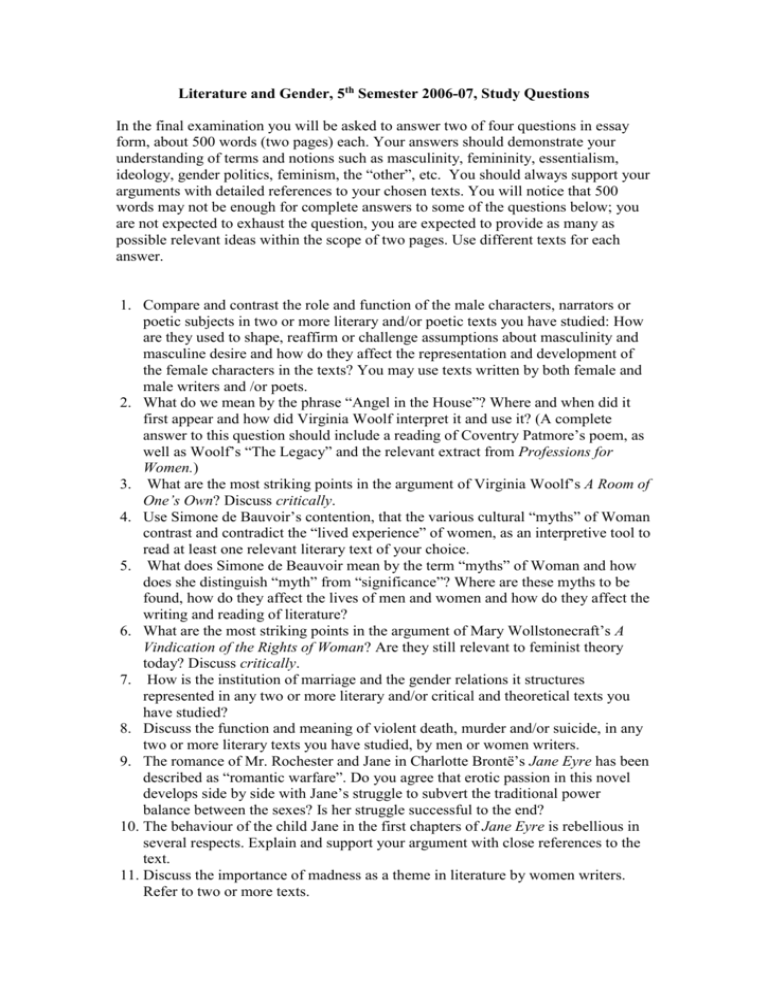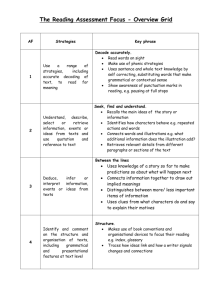study questions
advertisement

Literature and Gender, 5th Semester 2006-07, Study Questions In the final examination you will be asked to answer two of four questions in essay form, about 500 words (two pages) each. Your answers should demonstrate your understanding of terms and notions such as masculinity, femininity, essentialism, ideology, gender politics, feminism, the “other”, etc. You should always support your arguments with detailed references to your chosen texts. You will notice that 500 words may not be enough for complete answers to some of the questions below; you are not expected to exhaust the question, you are expected to provide as many as possible relevant ideas within the scope of two pages. Use different texts for each answer. 1. Compare and contrast the role and function of the male characters, narrators or poetic subjects in two or more literary and/or poetic texts you have studied: How are they used to shape, reaffirm or challenge assumptions about masculinity and masculine desire and how do they affect the representation and development of the female characters in the texts? You may use texts written by both female and male writers and /or poets. 2. What do we mean by the phrase “Angel in the House”? Where and when did it first appear and how did Virginia Woolf interpret it and use it? (A complete answer to this question should include a reading of Coventry Patmore’s poem, as well as Woolf’s “The Legacy” and the relevant extract from Professions for Women.) 3. What are the most striking points in the argument of Virginia Woolf’s A Room of One’s Own? Discuss critically. 4. Use Simone de Bauvoir’s contention, that the various cultural “myths” of Woman contrast and contradict the “lived experience” of women, as an interpretive tool to read at least one relevant literary text of your choice. 5. What does Simone de Beauvoir mean by the term “myths” of Woman and how does she distinguish “myth” from “significance”? Where are these myths to be found, how do they affect the lives of men and women and how do they affect the writing and reading of literature? 6. What are the most striking points in the argument of Mary Wollstonecraft’s A Vindication of the Rights of Woman? Are they still relevant to feminist theory today? Discuss critically. 7. How is the institution of marriage and the gender relations it structures represented in any two or more literary and/or critical and theoretical texts you have studied? 8. Discuss the function and meaning of violent death, murder and/or suicide, in any two or more literary texts you have studied, by men or women writers. 9. The romance of Mr. Rochester and Jane in Charlotte Brontë’s Jane Eyre has been described as “romantic warfare”. Do you agree that erotic passion in this novel develops side by side with Jane’s struggle to subvert the traditional power balance between the sexes? Is her struggle successful to the end? 10. The behaviour of the child Jane in the first chapters of Jane Eyre is rebellious in several respects. Explain and support your argument with close references to the text. 11. Discuss the importance of madness as a theme in literature by women writers. Refer to two or more texts. 12. Discuss the function and meaning of madness in any two literary and/or poetic texts by male and/or female writers. 13. The reader of Jane Eyre frequently encounters images, both literal and metaphorical, of confinement, imprisonment, slavery, violence and abuse. To what purpose and effect does the novel employ such imagery? Discuss with reference to at least three examples from the novel. 14. Who is Bertha Mason and what is her function in Jane Eyre? (A complete answer to this question should show your awareness of the critical controversy that has been provoked by the figure of Bertha.) 15. Is the notion of the “Other” (applied to woman, foreigner, person of colour or any other “outsider” or “outcast”) useful as a critical tool to our reading of Jane Eyre and in what way(s)? 16. Discuss the importance of spatial imagery (the descriptions of houses, rooms, gardens, etc. and their function) in two or more literary texts by men and/or women writers. 17. Read any two or more literary texts by women and/or men writers from a feminist perspective: To what extent do your chosen texts reaffirm or challenge existing cultural norms? 18. Is it possible to argue that forceful emotions (anger, hatred, terror, etc.) in Jane Eyre lead to a form of cultural and social critique? 19. Compare and contrast the way a woman’s death is treated as a theme in two different literary or poetic texts, one by a man and one by a woman writer.





